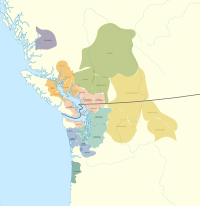Linguas salish
| Linguas salish | ||
|---|---|---|
| Falado en: | Estados Unidos de América e o Canadá | |
| Total de falantes: | ||
| Familia: | Americana Linguas salish | |
| Escrita: | latino | |
| Códigos de lingua | ||
| ISO 639-1: | --
| |
| ISO 639-2: | ---
| |
| Mapa | ||

| ||
| Status | ||
As linguas salish son unha familia de linguas do Pacífico noroeste de América do Norte, faladas na provincia canadense da Columbia Británica e nos estados de Washington, Oregón, Idaho e Montana, nos Estados Unidos.[1] As linguas salish caracterízanse por ser aglutinantes e consoantes silábicas. Por exemplo, a palabra nuxalk clhp’xwlhtlhplhhskwts’ (xɬpʼχʷɬtʰɬpʰɬːskʷʰt͡sʼ), quere dicir "el tivera [na súa posesión] unha planta de abuxo",[2] ten doce consoantes obstruentes seguidas sen vogais fonéticas nin fonémicas.
As linguas salish son un bloque xeograficamente contiguo, agás a lingua nuxalk (Bella Coola), na costa central da Columbia Británica, e a extinta lingua tillamook, ao sur da costa central de Oregón.
Notas[editar | editar a fonte]
- ↑ "First Nations Culture Areas Index". the Canadian Museum of Civilization.
- ↑ Bagemihl, Bruce (1991). "Syllable Structure in Bella Coola". Linguistic Inquiry 22 (4): 589–646. ISSN 0024-3892. JSTOR 4178744.
Véxase tamén[editar | editar a fonte]
Bibliografía[editar | editar a fonte]
- Beck, David. (2000). Grammatical Convergence and the Genesis of Diversity in the Northwest Coast Sprachbund. Anthropological Linguistics 42, 147–213.
- Boas, Franz, et al. (1917). Folk-Tales of Salishan and Sahaptin Tribes. Memoirs of the American Folk-Lore Society, 11. Lancaster, Pa: American Folk-Lore Society.
- Czaykowska-Higgins, Ewa; & Kinkade, M. Dale (Eds.). (1997). Salish Languages and Linguistics: Theoretical and Descriptive Perspectives. Berlin: Mouton de Gruyter. ISBN 3-11-015492-7.
- Davis, Henry. (2005). On the Syntax and Semantics of Negation in Salish. International Journal of American Linguistics 71.1, January 2005.
- Davis, Henry e Matthewson, Lisa. (2009). Issues in Salish Syntax and Semantics. Language and Linguistics Compass, 3: 1097–1166. Online.
- Flathead Culture Committee. (1981). Common Names of the Flathead Language. St. Ignatius, Mont: The Committee.
- Jorgensen, Joseph G. (1969). Salish Language and Culture. 3. Bloomington, Indiana: Indiana University Publications.
- Kiyosawa, Kaoru; Donna B. Gerdts. (2010). Salish Applicatives. Leiden, Netherlands: Koninklijke Brill NV.
- Kroeber, Paul D. (1999). The Salish Language Family: Reconstructing Syntax. Lincoln: University of Nebraska Press in cooperation with the American Indian Studies Research Institute, Indiana University, Bloomington.
- Kuipers, Aert H. (2002). Salish Etymological Dictionary. Missoula, MT: Linguistics Laboratory, University of Montana. ISBN 1-879763-16-8
- Liedtke, Stefan. (1995). Wakashan, Salishan and Penutian and Wider Connections Cognate Sets. Linguistic Data on Diskette Series, no. 09. Munchen: Lincom Europa.
- Pilling, James Constantine. (1893). Bibliography of the Salishan Languages. Washington: G.P.O.
- Pilling, James Constantine (2007). Bibliography of the Salishan Languages. Reprint by Gardners Books. ISBN 978-1-4304-6927-8
- Silver, Shirley; Wick R. Miller. (1997). American Indian languages: Cultural and Social Contexts. Tucson: University of Arizona Press.
- Hamill, Chad (2012). Songs of power and prayer in the Columbia Plateau: the Jesuit, the medicine man, and the Indian hymn singer. Corvallis: Oregon State University Press. ISBN 978-0-87071-675-1. Arquivado dende o orixinal o 2015-09-25. Salishan language hymns.
- Thompson, Laurence C. (1973). The Northwest. In T. A. Sebeok (Ed.), Linguistics in North America (pp. 979–1045). Current Trends in Linguistics (Vol. 10). A Haia: Mouton.
- Thompson, Laurence C. (1979). Salishan and the Northwest. In L. Campbell & M. Mithun (Eds.), The Languages of Native America: Historical and Comparative Assessment (pp. 692–765). Austin: University of Texas Press.

